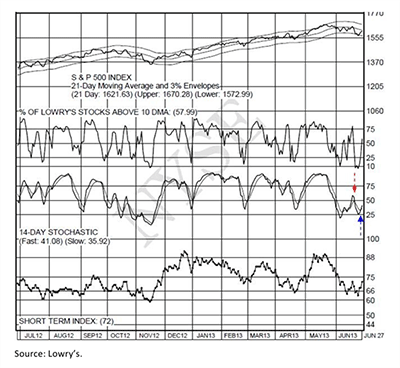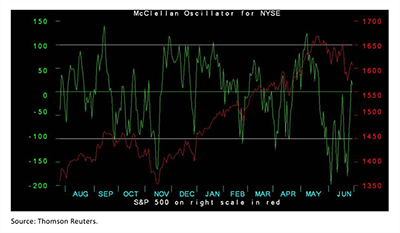“T-i-m-b-e-r-r-r!”
by Jeffrey Saut, Raymond James
July 1, 2013
“Sure Babe Ruth was good, but could he play hoops?”
“... The answer is, the Babe played hoops at least once, according to biographer Bob Creamer, in a pickup game with high school varsity players, and looked ‘pretty good.’ It is fairly certain, however, that the Bambino was no Air Ruth. ... The fact is that even for the greatest physical specimens, going from one sport to another and competing at high levels – let alone the highest levels – may not quite translate, for a variety of reasons. ... The man who was called ‘the greatest athlete of all time,’ Jim Thorpe, was an Olympic decathlon champion and football player who, a teammate said, ‘could out run a deer.’ But, he was a bust as a major league baseball player. ... It seems the hardest thing to do in sports is something that you may not have been trained in at an early age to develop the muscle memory, may not have the desire or may not have developed the requisite physical skills. ... Some talented athletes have been driven out of baseball because they feared being hit by a pitch. ‘Stepping into the bucket’ is the next step to departing the game. Fear of injury plays a role in sports, and while one athlete may deal with it in one arena, he may not in another.”
... Ira Berkow, Sports of the New York Times
Many investors have “stepped into the bucket,” or left the game altogether. Recall that “stepping into the bucket” is when a batter steps away from home plate on his forward swing, usually in response to the fear of getting hit in the head by the ball. The Wall Street parallel is that it seems one of the hardest things to do is something you may not have been trained in at an early age. To be sure, many investors are “wired backwards” in that they believe you need to have a “feel good” environment to have a good stock market. The reality is that when you have a “feel good” environment, the game is usually in the late innings. As often stated, “The equity markets do not care about the absolutes of good or bad, but rather are things getting better or worse. And, things are definitely getting better. However, in my speaking tour last week most investors don’t believe it. Nor do they believe the stock market has been rising because things are getting better. Indeed, many of the folks I talked to believe the only thing buoying the stock market has been the Federal Reserve. Even portfolio managers embrace this belief to a degree. Moreover, the recent selling squall has brought back investors’ fears that it is 2008 all over again. In fact, at my Salt Lake City presentation one financial advisor said, ‘Isn’t it amazing the stock market can go up 153% over the past four years and clients rarely called me. But, let it go down 7% in as many weeks and my phone lights up with the question ‘should we get out’.”
The following anecdote, taken from the aforementioned quote, well illustrates both the current emotion and direction of Wall Street:
“Trainer Angelo Dundee recalls when Wilt Chamberlain agreed to fight Muhammad Ali. Papers were drawn up and Dundee envisioned a big, easy pay day. ‘Now remember, champ,’ said Dundee, ‘when Wilt comes into the room to sign the contract, don’t say anything to scare him.’ But when the 7-foot Chamberlain walked through the door, Ali couldn’t resist. ‘T-i-m-b-e-r-r-r!’ he shouted. The fight never came off.”
“T-i-m-b-e-r-r-r” indeed, for despite the fact the S&P 500 (SPX/1606.28) has rallied roughly 3% from its June 24th intraday low of 1560, investors are still waiting for more “trees” to fall. The reason is investors’ confidence has been damaged once again by the viciousness of the consecutive 90% Downside Volume Days of June 19th and 20th where the D-J Industrials (INDU/14909.60) lost ~560 points. At the time I stated the history of such back-to-back Downside Days is for the SPX to be 1% higher 70% of the time one week later, 2.7% higher one month later 75% of the time, and 23.8% higher one year later 95% of the time. However, what’s been missing from the recent rebound has been a 90% Upside Volume Day, which would indicate the selling from the May 22nd downside reversal, into the June 24th low, was sufficient enough to exhaust the sellers. Hence, even though I have positive energy signals for this week, which could produce a rally into the potential double-top level between 1650 and 1687, I am disinclined to play it except for the nimblest of traders. Accordingly, I am sticking with the strategy calling for a double-top followed by the first meaningful decline of the year beginning this month. That said, I think SPX will be higher than its May 22nd intraday high of 1687.18 by year-end.
If the downside “call” proves correct, the good thing about such declines is they tend to show which stocks hold up the best. Speaking to that, it is interesting that companies generating 100% of their revenues from the U.S. (Domestics) have performed better on the upside, and held up better on the downside, than the Internationals. These names should be included in your “shopping list” as candidates for purchase in the anticipated decline. A few of the Domestics from Raymond James’ research universe that are quantitatively sound, are positively configured by my proprietary charting software, and have Strong Buy ratings from our fundamental analysts include: AutoZone (AZO/$423.69); Bed Bath & Beyond (BBBY/$70.95); O’Reilly Automotive (ORLY/$112.62); Regions Financial (RF/$9.53); UnitedHealth (UNH/$65.48); and Wells Fargo (WFC/$41.27).
The call for this week: Speaking of T-i-m-b-e-r-r-r, timber has been a really good investment over the years and our real estate team has penned a report titled “Timber Topics” that can be retrieved here. As for the equity markets, the SPX has rallied from the bottom of its 3% trading envelope (see chart on page 3), but has not shown any strong Upside Demand Days (read: Buying Power) needed to signal the June 24th bottom was THE bottom. Further, the McClellan Oscillator is no longer oversold and actually is moving into an overbought condition (see chart on page 3). Still, I have very positive energy signals for this week, which could produce a rally into the potential double-top level between 1650 and 1687. However, I am disinclined to play it, except for the most nimble of traders (read: very close stop-loss points). Verily, I am sticking with the strategy of a double-top formation, followed by the first meaningful decline of the year, beginning this month. That said, I think SPX will be higher than its May 22nd intraday high of 1687.18 by year-end. And this morning those “positive energy signals” are pulling stocks higher, helped by a sharp rally in Japan on better economic data that has quelled concerns about China. As well, worries regarding the end of Qeternity are abating, leaving the preopening SPX futures better by 9 points at 6:00 a.m.
















